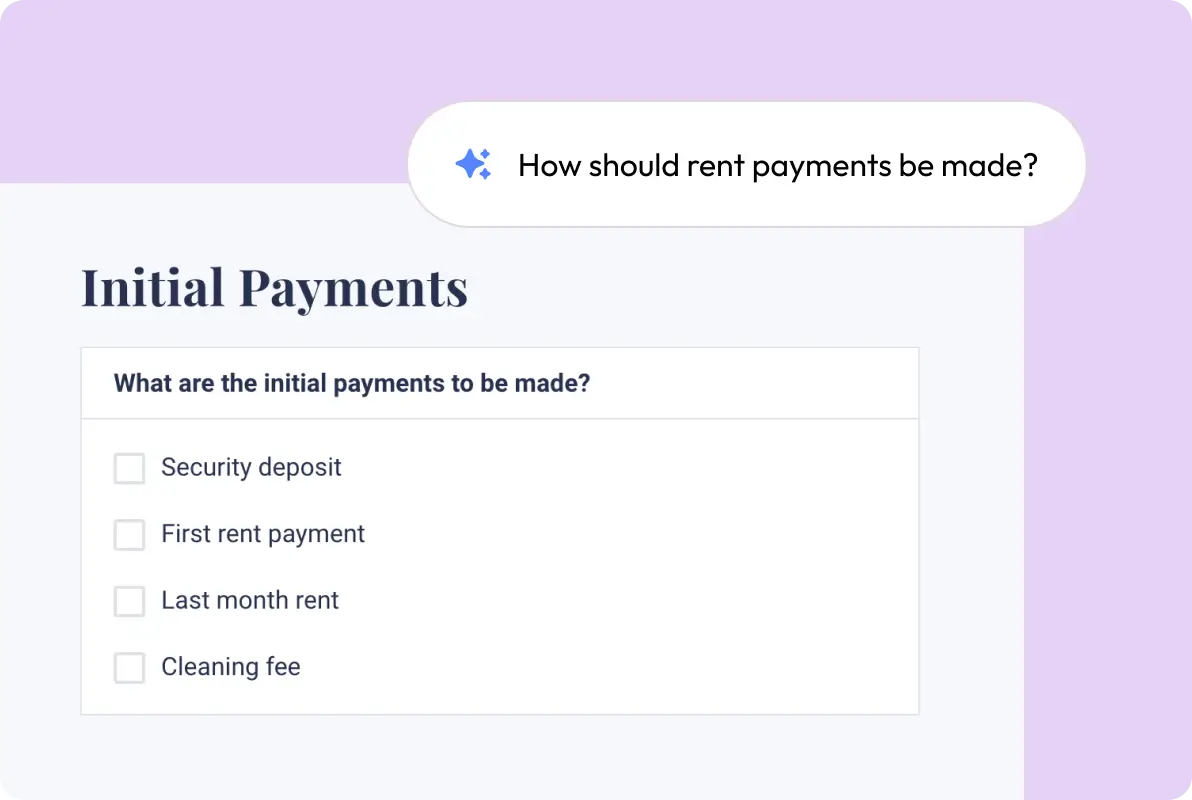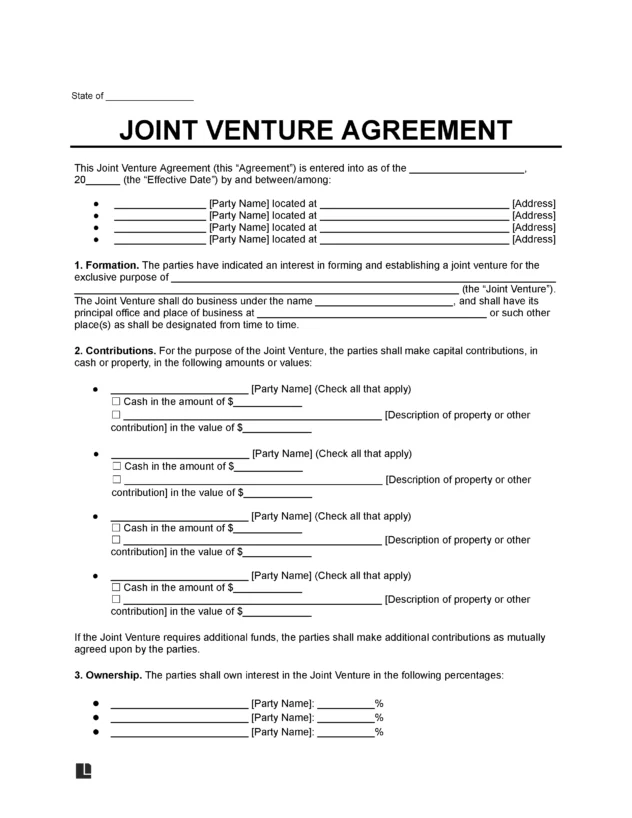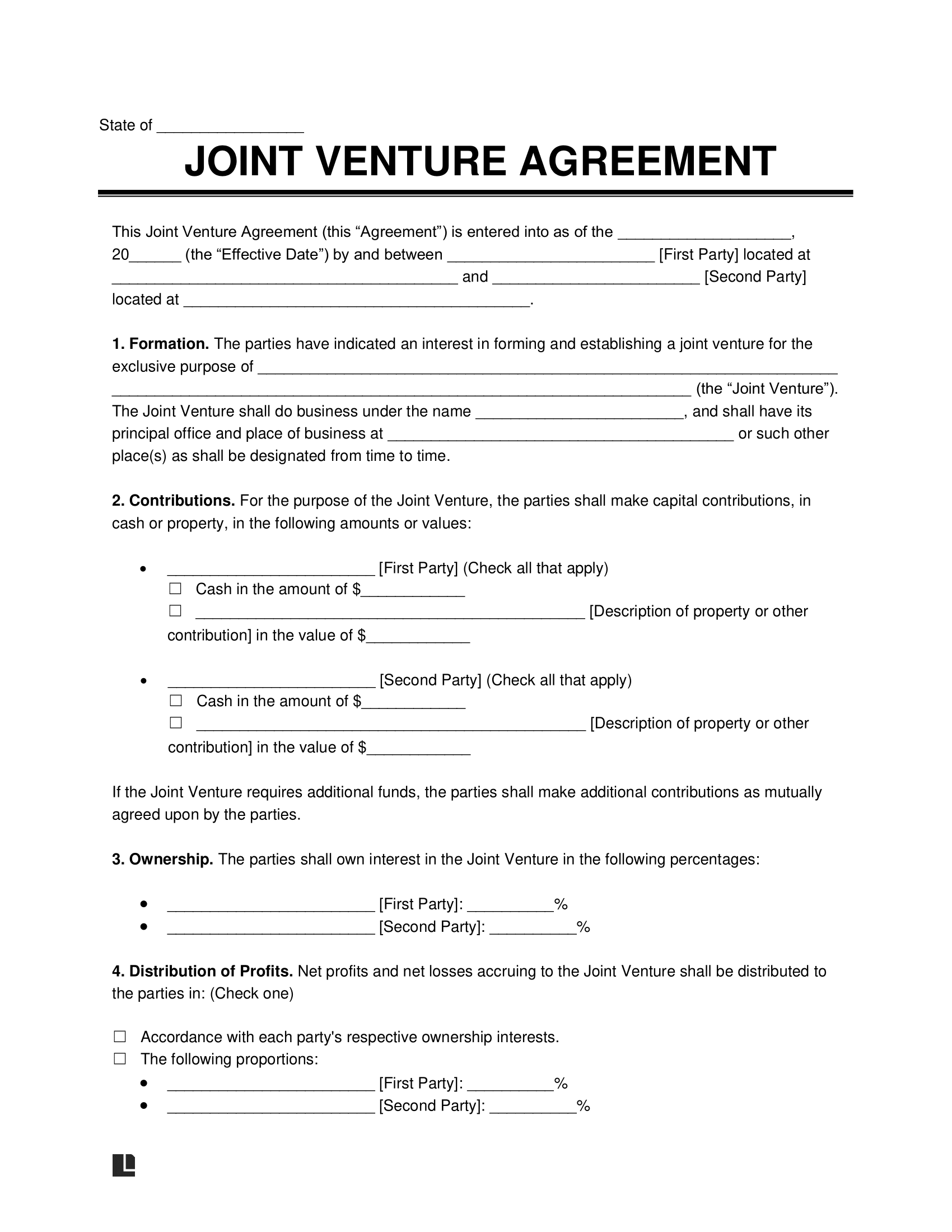What Is a Joint Venture Agreement?
A joint venture agreement is a written contract outlining the circumstances of parties pursuing a business activity or project. This agreement details the arrangement between separate entities (often with interrelated strengths) who combine their resources, capital, and expertise to accomplish a common goal.
Instead of creating a formal partnership or new legal entity, a contractual joint venture (JV) allows the parties to continue filing their tax returns separately yet still reap the financial advantages of a partnership, such as sharing resources and risks.
A well-written joint venture agreement clarifies each party’s expectations, responsibilities, and rights relating to the venture.
Is a Joint Venture Agreement Legally Binding?
When both parties execute a joint venture agreement properly, it’s legally binding. If one party doesn’t uphold their end of the agreement, the other party can initiate legal action against them.
Some elements that make this written agreement legally binding include the following:
- Offer and Acceptance: One company asks another to enter into an arrangement and proposes the terms of their collaboration. The parties can negotiate the specific terms but must agree to cooperate.
- Consideration: Each party receives something valuable from the arrangement. For example, one party gains access to a new market, while the other gains access to the first party’s industry expertise.
- Mutuality: Both parties agree to sign an enforceable contract.
- Legality: The entire agreement only contains lawful considerations and promises. For example, the companies agree to work in conditions that align with their jurisdiction’s labor laws.
- Capacity: Each party legally signs the contract. For example, they’ll ensure any representatives have legal authority to sign the document.
What to Include in a Joint Venture Agreement
It identifies the following fundamental elements:
- Parties or Co-Venturers: The entities that have agreed to work together.
- Financial Contributions: The amount of money, property, and time each co-venturer will invest.
- Management Structure: The people responsible for the venture’s day-to-day operations.
- Purpose: The scope of JV activities and the reasons to join resources and collaborate.
- Profits: How the parties will distribute profits, either based on contributions or another formula.
- Term: Whether the venture is for a limited time or an indefinite period.
- Assignment: Whether either party can assign their responsibilities to another entity (most documents require prior written consent from the other party).
- Confidentiality: Both parties agree to keep all proprietary information confidential.
- Exclusivity: Whether either party can perform business with other entities outside of the agreement.
- Termination: The conditions under which the joint venture will end.
How to Form a Joint Venture
Explore the steps to forming a joint venture so you can decide if this path is right for your existing business:
Step 1 – Find a Suitable Partner
Find a suitable partner who complements your company’s existing structure. For example, suppose your business developed an innovative new product, but you don’t have adequate distribution channels. You might look for a business partner with established channels and a good industry reputation.
Contact different distributions to assess their interest in partnering with you. Ensure you trust the company leaders you choose, evaluating their skills, industry expertise, and cultural fit. When you conduct this due diligence, you can have more confidence in your chosen partner.
Here are some elements to consider about a potential partner:
- The company’s financial situation
- The company’s expectations from the venture
- Other partnerships the company may already have (conflicts of interest)
- The company’s expressed its commitment to your proposed goals
Step 2 – Choose a Type of Joint Venture
Once you find a partner, you can negotiate with them to decide on the type of joint venture you’d like to start. Consider the two types:
- Contractual joint venture: A contractual joint venture is a business arrangement you enter with another company in which you both continue to operate separately. You only combine resources to strive toward common goals.
- Equity joint venture: An equity joint venture is a business arrangement in which you and another company create a new entity under which you conduct business. Each party will hold equity in the new company, and the new company will operate separately from the parties’ businesses.
Creating a separate legal entity is more complex and expensive, but it can offer more legal protection if an issue arises. A simple contractual agreement allows for more flexibility, as the parties don’t have to pay taxes and report profits for an entirely new entity. Instead, the profits flow through to each party’s business.
Step 3 – Draft a Joint Venture Agreement
Use our joint venture agreement template to start drafting your own document. Tailor it to your and your partner’s needs and preferences. Negotiate with the other party to ensure you detail mutually beneficial terms.
While drafting and signing this document, you should have legal representation for each party. A third party with legal knowledge for each entity can ensure the document is fair and legally enforceable.
Step 4 – Pay Taxes
No matter what kind of profit-seeking business you have, you must pay your share of taxes. The same applies to owners of joint ventures. The taxes you pay for your joint venture will depend on how you structure your arrangement.
If you and your partner create a separate entity, all its profits will be subject to taxation based on the business type. For example, C corporations pay a tax rate of 21% on profits they earn. Alternatively, limited liability companies (LLCs) account for business losses and income on each owner’s individual tax return.
Contractual joint ventures don’t file their own tax returns. Instead, their tax responsibilities flow to each party’s respective entity.
Step 5 – Abide by Other Regulations
Ensure you abide by federal, state, and local laws for your joint venture’s activities. For example, if you plan to use the labor of another entity’s employees as part of your joint venture agreement, you must follow applicable labor laws.
You might also need to acquire a business license or permit to legally operate, depending on the industry to which your joint venture belongs.








